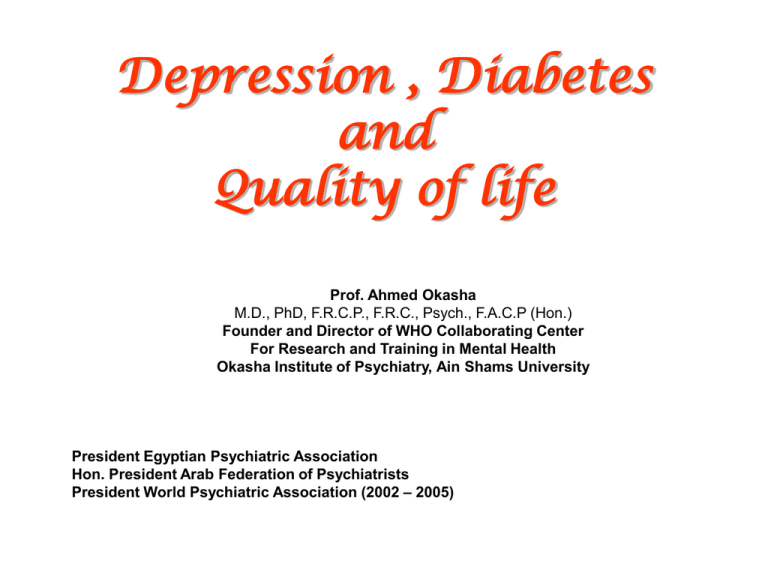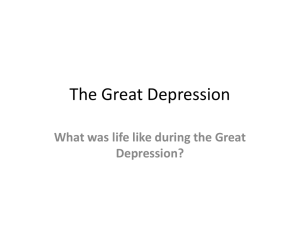
Depression , Diabetes
and
Quality of life
Prof. Ahmed Okasha
M.D., PhD, F.R.C.P., F.R.C., Psych., F.A.C.P (Hon.)
Founder and Director of WHO Collaborating Center
For Research and Training in Mental Health
Okasha Institute of Psychiatry, Ain Shams University
President Egyptian Psychiatric Association
Hon. President Arab Federation of Psychiatrists
President World Psychiatric Association (2002 – 2005)
What Is Happening in The Middle East?
Tunis
Libya
Egypt
Yemen
Bahrain
Syria
Morocco
Jordan
Uprise in the Arab World
• 60% of Arab World below 30 years
• Tunisia, Egypt, Yemen, Libya, Syria
• Common factors: Despotism, Security torture, Long
standining in power, violation of human rights…etc
• No democracy, transparency, accountability.
• Revolutions of dignity to the Arab Citizens
• Democracy, providing physical and mental health
are assets to wellbeing and happiness.
• In Egypt, first revolution by intellectual youth using
the technology of social networking
Psychiatric Disorders in the Community
Out of every 100 citizens
30% are suffering from a mental problem that
needs attention.
20% will seek traditional healers or general
practitioner’s (GPs) help.
10% will be recognized by the GP to be
psychiatric cases.
2.3% will be referred to the psychiatrist.
0.5% will need inpatient treatment.
Ten leading causes of burden of diseases, world,
2004 and 2030
2004
Disease or injury
As % of
total
DALYs
Rank
Rank
As % of
total
DALYs
2030
Disease or injury
Lower respiratory infections
6.2
1
1
6.2
Unipolar depressive disorders
Diarrhoeal diseases
4.8
2
2
5.5
Ischaemic heart disease
Unipolar depressive
disorders
4.3
3
3
4.9
Road trafic accidents
Ischaemic heart disease
4.1
4
4
4.3
Cerebrovascular disease
HIV/AIDS
3.8
5
5
3.8
COPD
Cerebrovascular disease
3.1
6
6
3.2
Lower respiratory infections
Prematurity and low birth
weight
2.9
7
7
2.9
Hearing loss, adult onset
Birth asphyxia and birth
trauma
2.7
8
8
2.7
Refractive errors
Road trafic accidents
2.7
9
9
2.5
HIV/AIDS
Neonatal infections and
other
2.7
10
10
2.3
Diabetes mellitus
COPD
2.0
13
11
1.9
Neonatal infections and others
Refractive errors
1.8
14
12
1.9
Prematurity and low birth weight
Hearing loss, adult onset
1.8
15
15
1.9
Birth asphyxia and birth trauma
Diabetes mellitus
1.3
19
18
1.6
Diarrhoeal diseases
Global burden of disease WHO 2004
COPD , chronic obstructive pulmonary disease
Prevalence of Depressive
Disorders in Different Patient
Populations*
6%
General population
9%
Chronically ill
33 %
Hospitalized
Geriatric
36 %
33 %
Cancer outpatients
Stroke
42 %
47 %
MI
45 %
Cancer.In-patients
39 %
Parkinson's disease
0%
10%
20%
30%
40%
50%
Prevalence
*There is a range of percentages depending on the study.
Diagnosis of Depression
Two questions:
During last month, have you often been
bothered by feeling down, depressed or
hopeless? (Pleasure).
During the last month, have you been
bothered by having little interest or
pleasure in doing things? (Interest)
Depression
Main presentation:
Fatigue
Lack of concentration.
Somatic symptoms (masked depression) e.g.
Headache, Backache, Paraesthesia.
Sleep (EMW), appetite, sex, behavior
Psychomotor agitation or retardation.
Malancholia.
Psychosis: self depreciation, nihilism, guilt
Who gets depressed?
Knol MJ. Twisk JWR, Beekman ATF, Heine RJ, Snock FJ, Pouver
F. Depression as a risk factor for the onset of type 2 diabetes
meillitus. Ameta-analysis Diabetologia 2006:49,837-845
Prevalence of DM
World Wide 285 Millions
2030 to be 439 Millions
Egypt 5 Millions
expected in
10% young.
Egypt rating among the World is number 10.
Face the Facts
Life Time Prevalence of Depression in
Diabetic Patients
36%
Depression
Female > Male
18%
Normal population
Female > Male
Kaplan & Sadock, 2002
The Stress Curve
Benefit
- Vitality
- Enthusiasm
- Optimism
- Mental alertness
- High productivity and creativity
Hazards
- Fatigue
- Irritability
- Lack of concentration
- Anxiety
- Illness
- Low productivity and creativity
Causes of Depression in Diabetic
Patients
1. Stress, dysregulation of HPA axis,
dysregulation of blood glucose.
2. Reaction associated with having a
chronic disease (e.g. denial, anger,
depression, anxiety, acceptance).
3. Strict dietary regimen.
4. Concern over guilt of inappropriate
following of dietary restriction.
Cont….
5. Significant chronic pain secondary to
neuropathy.
6. Effect on brain function {e.g. diabetes
induces vascular (cerebral ischemia)}.
7. Coincidence (chance association).
8. Side effects or complications from
medications.
Cognitive Dysfunctions in Diabetic
Patients
Impaired attention
Information processing
Memory (Short)
Problems solving
Language function
Visuo-constructional skills
Significant reduction of IQ
Holmes, 1990
Causes of Cognitive Impairment
Metabolic dyscontrol.
Keto acidosis.
Hyperosmolar states.
Recurrent hypoglycemia.
Chronic hypoglycemia.
High prevalence of CVS.
Depression.
Stress, Diabetes and Depression
Stress may produce:
anxiety – depression – hostility –
unexpressed anger - cynicism – mistrust
Acute stress → Activation of
sympathetic system :
1. Reduction of vagal tone which is protective
for the heart
2. Endothelial function is impaired → injured
→ thrombosis
3. Platelets more hyper-coagulable, more
sticky,increases platelet aggregation and
adhesion.
4. Haemoconcentration → increased blood
viscosity
Chronic Stress
1.
2.
3.
4.
5.
Platelets
Endothelium
Vagal tone
Activating cortisol system (Lipids –
Glucose, Hypertension)
Ovarian dysfunction, oestrogen is
probably very protective → it raises HDL
M.I.
After an episode of major depression, the
risk of myocardial infarction increased to
fivefold.
Subsyndromal forms of depression had a
twofold increased risk of myocardial
infarction.
6 months after MI:
Mortality rate : 17% in patients with depression ,
3% without .
12 months after bypass:
Those with depression had a higher incidence of
subsequent cardiac events, angina , heart failure
MI, repeat surgery.
MD is a significant risk factor for the
development of coronary artery disease and
stroke.
Frasure-Smith et al 1993
Connerney 2000
Nemeroff 2001
Aims of Treatment
Treatment
Reduce / Remove
signs & symptoms
Restore
role function
Minimize risk of
relapse / recurrence
Treatment Options
Antidepressant medication
Psychotherapy
Electro-convulsive therapy (ECT)
(Brain synchronization treatment)
Antidepressant Medication Classes
TCAs
Clomipramine
Imipramine
Amitryptiline
MAOIs
Phenelzine
Isocarboxazide
RIMA
Moclobemide
SSRIs
Fluoxetine, Sertraline,
Escitalopram,
Paroxetine, Fluvoxamine
SNRI
Venlafaxine, Duloxetine
Others
Mianserin, Tianeptine,
Nefazodone, Trazodone,
Mirtazapine, Maprotiline.
Drug: Drug Interaction
Use AD with the least Drug-Drug interaction
e.g. Sertraline, Ecitalopram, Mianserin
i.e. no induction
Or inhibition of liver enzymes
SSRI
Bleeding, hyponitraerina
Antidepressants
Taking moderate to high daily doses of
antidepressants for more than 2 years is
associated with an 84% increased risk for
diabetes, according to a large observational
study.
The increased risk was particularly notable
for (SSRI) paroxetine and the tricyclic
antidepressant amitriptyline.
Weight gain might explain much of the
relation between antidepressant use and
diabetes
Andersohn 2009
SSRI
The study found a 4-fold increased risk for
diabetes associated with the long-term use of
paroxetine in daily doses above 20 mg/day, but
not of fluoxetine, citalopram, or sertraline
Depression itself might be some how connected
to diabetes and pointed out that there is
evidence that patients who treat their
depression in ways other than with
antidepressants ( for example, with cognitive
behavior therapy) are also at high risk of
developing diabetes.
Andersohn 2009
Smoking
New research suggest that a combination
of type 2 diabetes and smoking may
place individuals with serious mental
illness (SMI) at even greater risk for death
than their counterparts with diabetes who
smoke but who do not have SMI.
Norra MacReady 2009
Consequences of Psychiatric
Morbidity in Diabetic Patients
Poorer glucose control.
Increase risk of complications.
Affected medication adherence and self
care regimes.
Impaired quality of life.
Lethal dose of insulin.
Poor outcome.
High frequency of (smoking, alcohol).
MYTH
REALITY
Depression is obvious
and easily recognized
and expressed by the
patient
Depression disorders are
overlapping, hardly
expressed by the patient
and constitute a major
problem in symptom
exaggeration
MYTH
Depression is
Secondary to GMD
activity
Treatment of the medical
disorder will relief
Depression.
REALITY
Depression requires
treatment intervention and
does not remit with relieve
of symptoms
What is Mental Health?
Mental health is more than the mere lack
of mental disorders.
Mental health is a state of well-being
whereby individuals recognize their
abilities, are able to cope with normal
stresses of life, work productively and
fruitfully, and make a contribution to their
communities
Quality of Life Versus Longevity of Life
Quality of life describes an individual’s
satisfaction with his or her general sense
of wellbeing. It is often measured as
physical , psychological and social
wellbeing.
Longevity of life at the expense of quality
of life is an empty prize.
Psychosocial Factors
1. Psychological factors may affect healthrelated behaviours such as smoking, diet,
alcohol consumption, or physical activity,
which in turn may influence the risk of
CHD and diabetes.
2. Psychosocial factors may cause direct
acute or chronic pathophysiological
changes, possibly by their effect on
neuroendocrine or immune systems.
3. Access to and content of medical care may
be influenced by social factors.
Personality and Social Networks
Psychological traits ( type A behaviour,
hostility, workaholic, time urgency)
Psychological states ( depression, anxiety)
Psychological work characteristics ( job
control , demands, support)
Social networks and social supports.
Social Support
Evidence that high levels of social support
are protective against CHD and diabetes,
while social isolation is related to
increased mortality risk.
It has been proposed that social supports
may act to buffer the effect of various
environmental stereos and hence increase
susceptibility to disease.
Alloway 1987
Social interaction
Social interaction leads to neurogenesis
and proliferation of dendrites in cells of the
hippocampus and increased dopamine in
the dopaminergic reward pathways.
Lack of social interaction leads to atrophy in
cells of the hippocampus, decreased
dopamine together with hopelessness and
helplessness.
Spitzer, 2002
Temperaments
(Genetic)
1. Depressive المزاج
2. Cyclothymic المزاج
3. Irritable المزاج
اإلكتئابى
النوابى
العصبى
4. Anxious المزاج
5. Hyperthymic المزاج
القلق
النشط
Akiskal 2003
Characters (Environmental)
مصداقية الذات
• Self- directedness: how well is a person,
responsible, reliable, goal oriented and self
confident.
التعاون
• Cooperativeness: how a person is considered
a part of human society. (i.e., tolerant, helpful,
compassionate), and self-transcendence.
تجاوز الذات
• Self-transcendence: a part of the universe as a
whole.
Well-being
• Well-being is not enhanced by wealth, power,
or fame, despite many people acting as if such
accomplishments could bring lasting
satisfaction.
• Character development does bring about
greater self-awareness and hence greater
happiness.
• The most effective methods of intervention all
focus on the development of positive emotions
and the character traits that underlie wellbeing.
“Social Capital" is defined as the ties that
bind families, neighborhoods , workplaces,
communities, and religious groups together
and find that it correlates strongly with
subjective wellbeing.
In fact the breadth and depth of individuals'
social connections are the best predictors of
their happiness.
Money can buy you happiness, but not
much. and above a modest threshold,
more money does not mean more
happiness.
Individuals usually get richer during their
lifetimes—but not happier.
As for individuals, so for countries. Ghana,
Mexico, Sweden, the United Kingdom , and
the United States all share similar life
satisfaction scores despite per capita
income varying 10-fold between the richest
and poorest country.
If money does not buy happiness, what
does?
In all 44 countries surveyed in 2002 by the
Pew Research center, family life provided
the greatest sources of satisfaction.
Married people live on average three years
longer and enjoy greater physical and
psychological health than the unmarried.
Having a family enhances wellbeing, and
spending more time with one's family helps
even more.
In fact the breadth and depth of individuals'
social connections are the best predictors of
their happiness.
Work is central to wellbeing, and certain
features correlate highly with happiness.
These include autonomy over how, where,
and at what pace work is done.
Trust between employer and employee.
Procedural fairness.
The more that governments recognize individual
references, the happier their citizens will be.
Free choice, and citizens' belief that they can affect
the political process, increase subjective wellbeing.
An association between unhappiness and poor
health:
Be happy with what you have got, “look
outwards—not to compare yourself unfavorably
with others, but to develop your relationship! with
them.
It is a surer route to happiness than the pursuit of
wealth.
Get Happy … It Is Good For You
• Embark on a loving relationship with another
adult, and work hard to sustain it.
• Plan frequent interactions with friends, family,
and neighbours (in that order).
• Make sure you are not working so hard that
you have no time left for personal
relationships, and leisure.
• In your spare time, join a club, volunteer for
community service or take up religion.
• Happiness should become the goal of public
policy and the progress of national happiness
should be measured and analyzed as closely
as the growth of gross national product.
• This means that public policy should be
judged by how it increases human happiness
and reduces human misery.
Happy Lives
Pleasant life:
• Where you experience a succession of
pleasures that lose their effect with repetition.
Good life:
• Where you play your strengths and are
engaged.
Meaningful life :
• Where you put your strengths at the services
of something higher than yourself.
Conclusion
Positive Steps for Mental Health
(WHO)
1. Accepting who you are
2. Talking about it
3. Keeping active
4. Learning new skills
5. Keeping in touch with friends
6. Doing something creative
7. Getting involved
8. Asking for help
9. Relaxing
10.Surviving
Make Your Choice
Be successful, competitive, workaholic
and die younger.
OR
Be less ambitious, lower income, more
relaxed and live longer.








